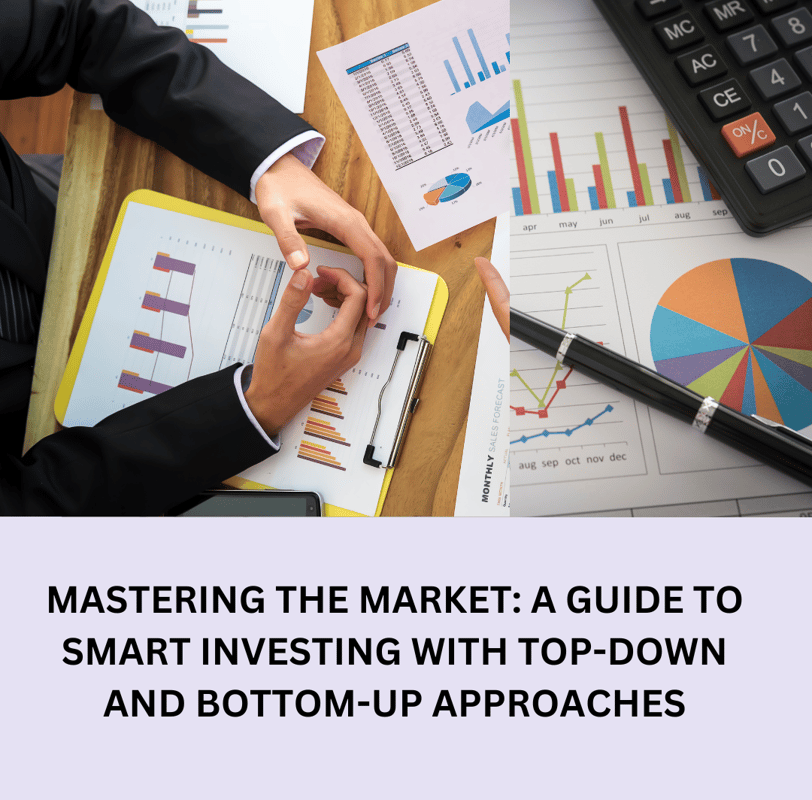Mastering the Market: A Guide to Smart Investing with Top-Down and Bottom-Up Approaches
Navigate the stock market with confidence! Learn how top-down and bottom-up approaches help identify winning stocks and make smart investment decisions
EXPERT GUIDE
12/24/20242 min read


Investing in the stock market can be thrilling, but venturing in without a strategy is like sailing the high seas in a paper boat. To make informed decisions, investors employ two main research approaches: top-down and bottom-up.
Top-Down Approach: Starting with the Big Picture
Imagine zooming out from a bustling city street to see the entire landscape. That's the top-down approach. It begins by analyzing macroeconomic factors like:
Gross Domestic Product (GDP): A country's overall economic health. A rising GDP indicates potential growth for companies within that economy.
Interest Rates: Lower rates generally encourage borrowing and investment, potentially boosting stock prices.
Inflation: Rising prices can erode corporate profits and investor returns.
Currency Fluctuations: A strong currency can make exports more expensive, impacting companies reliant on foreign trade.
Once you have a grasp of the big picture, you can zoom in on specific industries that seem poised for growth based on these factors. Let's say a booming tech sector catches your eye.
Industry Analysis: Diving Deeper
Within your chosen industry, research sector performance over time, identifying high-performing segments. Think of it like choosing a promising neighborhood within the bustling city.
Now, let's zoom in further to specific companies within that sector.
Company Selection: Finding the Gems
Future Plans: Does the company have a clear and compelling vision for the future?
Competitive Advantage (Moat): What makes them stand out from competitors? Is it a strong brand, unique technology, or efficient operations?
Financial Performance: Scrutinize financial statements like the income statement, balance sheet, and cash flow statement. Key ratios like I have mentioned come into play here:
Operating Profit Margin (OPM): Measures profitability from core operations.
Market Capitalization: The total value of outstanding shares.
Dividend Yield: The annual percentage of the share price paid out as dividends.
Return on Capital Employed (ROCE): Measures how efficiently the company uses its invested capital.
Debt-to-Equity Ratio: Indicates the company's financial leverage (debt burden).
Return on Equity (ROE): Measures the profitability generated from shareholders' equity.
Promoter Holding: The percentage of shares owned by the company's founders or key decision-makers.
Earnings Yield: The inverse of the P/E ratio, indicating the return on investment based on earnings.
Pledged Percentage: The portion of shares used as collateral for loans.
Sales Growth: The rate at which the company's revenue is increasing.
Industry PE Ratio: The average price-to-earnings ratio of companies in the same industry.
Price-to-Free Cash Flow Ratio: Measures a company's valuation based on its ability to generate cash.
Current Ratio: Assesses the company's ability to meet short-term obligations.
Profit Growth: The rate at which the company's profits are increasing.
Dividend Payout Ratio: The percentage of profits distributed as dividends to shareholders.
Analyzing these ratios paints a picture of the company's financial health, profitability, and future prospects. Remember, no single ratio tells the whole story, so consider them in conjunction with other factors.
Bottom-Up Approach: Starting with the Ground Floor
The bottom-up approach takes the opposite route, starting with individual companies that pique your interest. You might be familiar with a company's product or service, or hear positive buzz about its performance.
Once you've identified a company, you delve into its financial statements, business model, competitive landscape, and management team. The same key ratios and financial statement analysis used in the top-down approach apply here.
Thank You
Prabhav Maheshwari
EASE INVESTOR
© 2024. All rights reserved.
EASE INVESTOR
